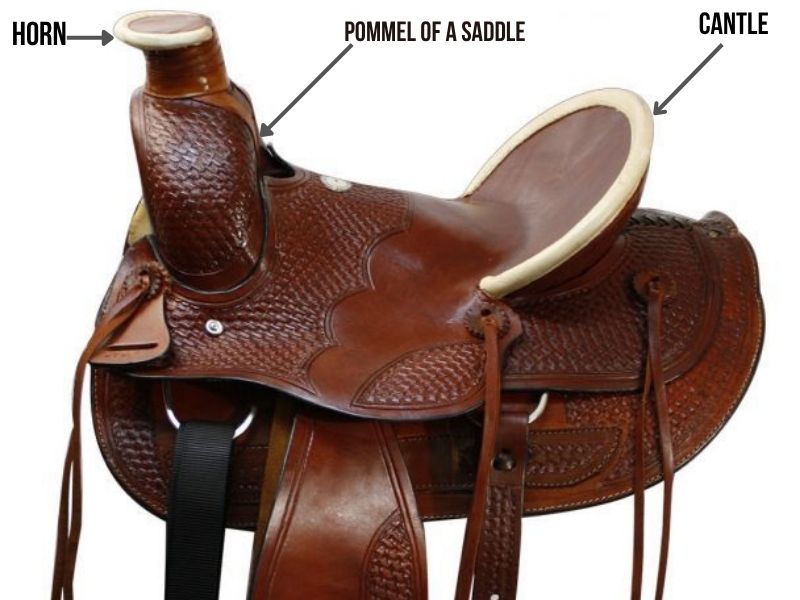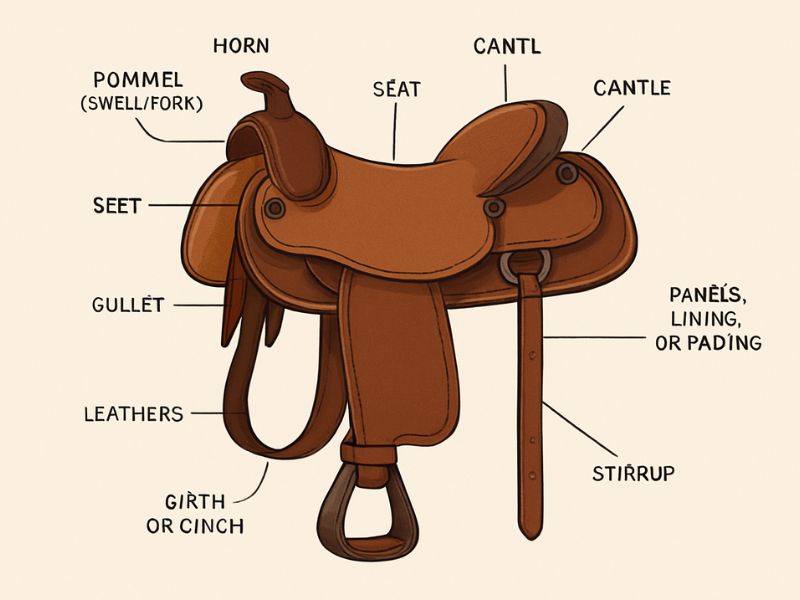Before buying a new saddle, it is important for new riders or horse owners to know the anatomy of saddles. Now many horse riders overlook this raised front part of a saddle. But they don’t understand how the pommel improves the comfort, safety, and balance of both horse and rider.
That’s why it’s important to understand the functions and purposes of this frontal part of the saddle. This guide will help you understand what the pommel is and how it improves the safety and balance of riders.
- What Is the Pommel of a Saddle?
- What Is the Purpose of the Pommel?
- Pommel vs Horn: What’s the Difference?
- What Is the Difference Between a Pommel and a Cantle?
- Types of Pommel Designs (Western & English)
- How the Pommel Affects Saddle Fit & Comfort
- Related Saddle Parts: How They Work Together
- Conclusion
- FAQs About Saddle Pommels
What Is the Pommel of a Saddle?
In simple words, the pommel is a raised front that gives shape and support to the front of the saddle. It plays an important role in horse comfort, but it is an overlooked component of horse tack.
The pommel is also called the saddle knob, swell, or fork because it depends on the saddle type and regional terminology. It works with the cantle, which is a raised part of the saddle that supports the rider’s seat.
What Is the Purpose of the Pommel?
The pommel serves many purposes in the saddle. It helps in overall balance, support, and safety for both horse and rider. It provides structural support to the front of the saddle tree, which makes the saddle strong and safe.
It also plays an important role in rider security. During jumps or quick stops, it works as a physical barrier to prevent riders from sliding too far forward. The pommel helps in maintaining proper withers clearance, which is important for avoiding pressure on the horse’s spine.
In western saddles, it comes with a horn attachment that supports the horn used in roping and ranch work.nIn high-performance or rough terrain riding, it serves as a contact point for the rider.
Pommel vs Horn: What’s the Difference?
Some people get confused between the pommel and the horn. The pommel is the actual structure that comes into the front of the saddle. It is a part of the saddle tree. On the other hand, the horn is an attachment that sits at the top of the pommel in western saddles.

In simple terms, the horn cannot exist without the pommel. The pommel is the main foundation, and the horn is just an extension that is only found in western saddles. The horn is mostly used for roping cattle or as a handhold, while the pommel gives the core strength and shape to the saddle.
What Is the Difference Between a Pommel and a Cantle?
The pommel and cantle are the front and back supports of your saddle seat. The pommel is the raised front part near the horse’s withers, while the cantle is the raised back part that supports the rider’s back.
So they both help riders in maintaining balance and proper posture during rides. The pommel supports forward motion, and the cantle supports backward movement and upright posture.
Types of Pommel Designs (Western & English)
Both English and western saddles come with different pommel styles. The style of the pommel depends on the type of riding they are designed for.
There are some common pommel designs that you see in western saddles. One of them is a slick fork, which is a narrow pommel with very little swell. It gives the rider closer contact and is mostly preferred for different types of ranch work. Then there is the swell fork or undercut swell, which gives riders extra support and keeps them secure in the saddle.
A high pommel is mostly used in trail saddles or training saddles. It provides more security to riders when riding on uneven terrain or working with young horses. Then there is a low pommel, which is mostly used in performance saddles to give the rider more freedom to move.
The pommel shape is different in English saddles. In English saddles, the cutback pommel has a dipped front, which is useful for horses with high withers. It prevents the saddle from putting pressure in the sensitive area, which gives more comfort to both horse and rider.
Then there is a flat pommel, which has very little rise and is most suitable for dressage saddles or jumping saddles. Its minimal front helps the rider to move freely. Some English saddles also have a curved pommel, which makes a balance between wither clearance so the rider can find proper position.
Western vs English Saddle Pommel: What’s the Difference?
| Feature | Western Saddle Pommel | English Saddle Pommel |
|---|---|---|
| Shape | Tall, raised, often includes a horn | Flat, cutback, or gently curved |
| Purpose | Supports horn and offers grip for work | Provides balance for posture |
| Style Variations | A fork, undercut swell, slick fork, swell fork | Flat or cutback pommel (dressage/show) |
| Use Case | Roping, trail riding, ranch work | Jumping, dressage, show events |
How the Pommel Affects Saddle Fit & Comfort
If the pommel is not fitted correctly, it can cause a lot of issues for both the horse and the rider.
- Wither Clearance: The pommel should provide enough clearance to avoid pinching the horse’s withers.
- Spinal Relief: Prevents the saddle from resting on the spine.
- Rider Balance: Influences how your hips and legs align with the saddle.
- Saddle Stability: Contributes to even weight distribution.
- Freedom of Movement: The pommel’s shape affects how freely the horse can move its shoulders.
The pommel should be fitted correctly. A low pommel can cause discomfort and even injury, and a too-high pommel is also a sign of wrong saddle fitting.

Related Saddle Parts: How They Work Together
It is important to know about overall saddle anatomy to understand how the pommel works better.
- Cantle: Cantle gives rear support to the rider’s back; it is the opposite of the pommel.
- Gullet: The gullet works in the center for spinal clearance under the pommel.
- Seat: Pommel and cantle play an important role in shaping the seat where the rider sits.
- Fenders, Flaps, Stirrup Leathers: These are the attached components that provide strong support to the rider’s legs.
- Horn: Horns are found at the top of the pommel in western saddles. They are used as a handhold or for roping cattle.
All these parts make the saddle comfortable, more functional, and give more control to the rider.
Conclusion
Whether you are a beginner rider or a seasoned horseman, it is important to know about the pommel of the saddle to make your riding experience balanced and comfortable. It looks like a small part of the saddle, but it plays a vital role in providing support to both the horse and the rider.
It’s crucial to check the pommel height, wither clearance, and how it works with the gullet and cantle. A well-designed pommel helps in controlling pressure points, promotes balance, and enhances your ride.
FAQs About Saddle Pommels
- Do All Saddles Have a Pommel?
- Yes. While styles vary, all saddles have some form of pommel as part of the structural tree.
- Can I Hold the Pommel While Riding?
- You can, especially for stability or in training. But in most disciplines, it’s better to rely on reins and leg cues.
- Is the Pommel Adjustable?
- Some modern saddles come with adjustable gullets that indirectly adjust pommel width. But traditional pommels are fixed.
- Can the Pommel Be Repaired?
- If damaged, the pommel (part of the tree) may require professional repair or replacement of the saddle tree.
